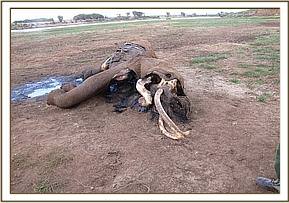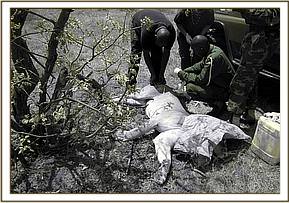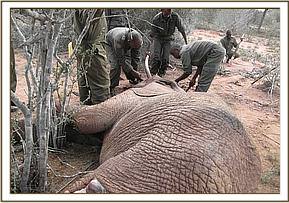Introduction
The month under review witnessed average number of cases of which elephant cases still maintained number one spot followed by the carnivores. Rains have started falling and sooner or later the region will be green with foliage and numerous watering points which come as a relief to the Tsavo wildlife. In the month the unit handled several cases of arrow and bullet wounds in elephants and injuries in lions and hyenas and summed it up with a collaring operation in the conflict prone Kuku ranch.
Treatment of a lame elephant calf in Galana river, Tsavo east, 4th Nov.
The calf was spotted by the river bank struggling to move in vain for few days with her mother by her side. The unit moved in to assist her but was held back by the raging waters of the river which is also infested with crocodiles and hippos! We had to swim across the river to access the sick calf with her mother protecting her. Her mother was first immobilized using 16 mgs of etorphine then followed by the calf with 5 mgs.
Examination revealed fractures and splintering of the right elbow joint that made movement impossible. A decision was made to euthanize as it was impossible to swim with the immobilised calf across the river in order to move her to an orphanage. Autopsy revealed the multiple fractures probably caused by a lion or crocodile bite.


Examination and tusk retrieval of an elephant carcass in Galana river, 4th Nov.
After the vet team was through with injured elephant calf, we encountered an elephant carcass some kilometres upstream about two weeks dead and tusks intact. The cause of death could not be ascertained due to advanced stage of decomposition and carnivore activity. The sex was female aged between 30-35 years.
The tusks were recovered and taken to Tsavo east national park headquarters for custody.

Treatment of an elephant bull in Kishushe area of Tsavo west, 7th Nov.
The bull in kishushe was spotted by fence attendants who informed the Sheldricks desnaring team nearby. After a thorough search the elephant was not spotted an aerial support was requested. The elephant was seen nearby by the aeroplane and immobilized using 18 mgs of etorphine propelled in a dan inject dart system. He fell on the wrong side and was rolled over using a land cruiser and ropes. A large lacerating wound on the left front limb stretching from the elbow joint to near the armpit was discovered and probably caused by a snare.
The wound was washed thoroughly using water mixed with hydrogen peroxide until all the dead tissue debris was removed leaving a raw wound. Tinture of iodine was splashed onto the wound and covered with oxytetracycline spray. A final coat of green clay was used to cover the wound. Long acting antibiotics and anti-inflammatories were injected intramuscularly. He was finally assisted onto his feet after he failed to stand on his own.
Examination and release of a problematic hyena, Tsavo east, 8th Nov
The Hyena caused problems with the community by preying on their livestock. KWS problematic animal control team trapped and brought the hyena to the veterinary office for examination and decide its fate. The hyena was immobilized using 150 mgs of ketamine and 2 mgs of meditomidine. All parameters including teeth, health status and claws were examined and found to be alright. He was treated for superficial wounds and released back to Tsavo east national park.
Capture of an abandoned elephant calf along Galana River, Tsavo east, 9th Nov.
The elephant calf was reported to be alone by tourists along Galana River with no family around it. It was feared he could be eaten by carnivores. A team from Voi stockade teamed up with the vet team to carry out the rescue. After a brief chase he was finally captured and taken to a nearby airstrip where he was airlifted to Nairobi orphanage.
Treatment of a young lame elephant bull in Mbulia ranch, maktau, 11th Nov.
The young bull was reported struggling to walk as it try to look for water near a dry water point in the ranch. He was approached and darted on foot using 7 mgs of etorphine in a dan inject dart system. After extensive examination no wound was discovered and a tentative diagnosis of sprain/dislocation was made. Long acting antibiotics and anti-inflammatory drug flunixine meglumine was injected.
He was finally revived and assisted up by use of ropes and based on his age, he has good chances of recovery.
Treatment of an elephant cow with multiple bullet wounds in Taita ranch, 16th Nov.
The female elephant was seen walking with a lot of pain and staying near water points in the ranch. She was easily traced and immobilized using 16 mgs of etorphine in a dan inject dart system. A bullet wound on the front right leg, the back and the abdomen were observed, probed and treated. No bullet head was recovered and the wounds were given poor prognosis of healing due to foreign material reaction in the body. Long acting antibiotics and anti-inflamatory drugs were administered. She was finally revived and assisted to wake up.
Desnaring of an eland in Haller park, Mombasa, 18th Nov.
The unit was called in to remove a snare on an eland bull at haller park sanctuary, Mombasa. The snare was thought to have been placed by neighbouring communities looking for bush meat. The bull is the breeding male and important in the herd. He was immobilized using 12 mgs of etorphine and 60 mgs of domosedan. He ran for a short distance then fell down. A thick wire snare was removed from his neck and wounds underneath treated. He was finally revived using Atipemazole Hcl and Naltrexone IV into the jugular vein. He woke up and staggered briefly.


Treatment of a lioness with a fractured front limb in Dida harea wind mill, Tsavo east, 19th Nov.
The lioness was reported to be limping near a water hole by tourists visiting the park. As the team moved in from the coast, she was found in a nearby bush in great pain and unable to walk. She was immobilized using 300 mgs of ketamine and 4 mgs of meditomidine. It went down well and upon examination a complete fracture of left humeral bone. She was transferred to the vet clinic where close examination supported the earlier diagnosis and was euthanized. Autopsy confirmed a complete fracture of the left humeral bone.


Rescue of an elephant bull that fell into a septic tank in Sarova salt lick lodge, 25th Nov.
The elephant bull was found trapped inside the septic tank in Sarova salt lick lodge in the morning having crushed the top cover from its massive weight. With the tank nearly submerging an adult bull, several attempts to pull him out failed and the team resorted to filling the tank with stones for the elephant to pull himself out. After several tractor loads of stones, the elephant managed to come out but with the fence wires around his legs. He was pursued again and immobilised using 18 mgs of etorphine, wire snare removed and wounds treated. The dry spells witnessed in the region in the past have lead to several cases of elephants falling into septic tanks while searching for water.
Lion collaring exercise in Kuku group ranch adjacent to Tsavo west, 25th- 30th Nov.
Kuku group ranch is a community wildlife conservancy adjacent to Tsavo west national park and host to numerous wildlife species that included lions, elephants, numerous grazers and other carnivores. Constant conflict between carnivores especially lions and the community necessitated monitoring to reduce community anger towards wildlife. Four satellite linked collars were bought and the unit was requested to assist in collar deployment. The exercise was carried out at night with use of a calling station to attract the lions. A young lioness was collared first, followed by two other male lions. A third mane less lion confused with a lioness was set free and his dominant brother was collared.
The information from the collars will be critical in monitoring the lion movements and understanding the nature of human- carnivore conflicts in the area.
Treatment of an injured young elephant bull in Taita ranch, 30th Nov.
The young elephant bull was seen dragging its hind leg and had difficulty in moving. He was swiftly immobilized using 16 mgs of etorphine and fell on the wrong side. A rope tied onto a vehicle was used to turn him around. The left hind limb was diagnosed to have a knee dislocation of unknown origin. After careful assessment of the security situation in the area and the pain he was going through, it was deemed good to euthanize him to reduce suffering and as he was an easy target for poachers roaming the ranch.


Treatment of an injured elephant bull (former orphan) near Voi stockade, Tsavo east, 3rd Dec.
The former orphan was seen with an arrow injury on the leg when they visited the Voi stockade as they usually do. The leg injury was oozing some pus. He was immobilized using 17 mgs of etorphine propelled by a dan inject dart system. The wound on the right front leg. It was cleaned using hydrogen peroxide mixed with water, doused with tincture of iodine and covered with green clay. He was declared out of danger and revived to rejoin his herd.
Conclusion and acknowledgement
The unit will be breaking off for their annual leave in the month of December and cases will be attended by Nairobi vet department through the skyvet initiative. The region is now wet and green after the recent showers and cases are expected to assume a downward trend.
The unit would like to thank its sponsors ViER PFOTEN through the David Sheldrick Wildlife Trust (DSWT) for their continued support to the unit. We also acknowledge assistance from Kenya Wildlife Service (KWS) through the head vet and capture services department and the assistant director Tsavo conservation area.
Report by: Dr Jeremiah Poghon






































